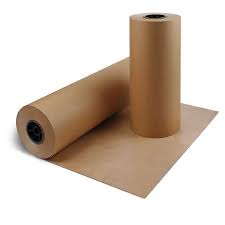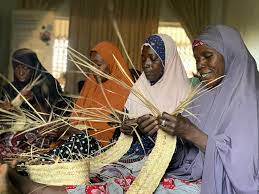
The word kraft comes from German which means “strong” and it is a paper or paperboard with a higher tear resistance and strength. It is mostly used in the packaging industry and is created from wood pulp or recycled materials with chemicals added to boost the strength, thickness, and durability of the fiber while preserving its light weight.
Typically, chemicals are added to kraft paper to increase its thickness, strength, and durability while preserving its low weight. Colored kraft paper, white or bleached kraft paper, black kraft paper, white or bleached kraft paper, natural recycled kraft paper, and printed craft paper are some of the most prevalent forms of kraft paper.
Sacks, envelopes, bags & pouches, composite cans, and cartons are only a few of the applications. The demand for kraft papers has increased as environmental concerns about usage of recyclable and biodegradable packaging have grown. Kraft papers are increasingly being made from natural recycled materials, which have less strength than virgin natural craft paper but are more eco-friendly and strong enough to fill vacant applications.
The global kraft paper market size reached US$ 16.7 Billion in 2022. Looking forward, IMARC Group expects the market to reach US$ 23.6 Billion by 2028, exhibiting a compound annual growth rate (CAGR) of five point nine percent (5.9%) during 2023-2028.
The shifting consumer preferences toward compostable and sustainable packaging materials owing to the rising awareness regarding the detrimental impact of plastic and other non-biodegradable variants are primarily driving the global kraft paper market. Apart from this, the expanding use of kraft paper in gift wrapping, events, weddings, etc., due to their colorful creativity, aesthetic appeal, and textured properties, is also stimulating the market growth.
Moreover, the increasing demand for highly technical saturated kraft paper that can be customized to meet unique needs in countertops, partitions, and flooring applications is further creating a positive outlook for the global market. Additionally, the elevating usage of kraft paper in the e-commerce sector for packaging on account of various associated benefits, such as folding resistance, toughness, and high-strength compression performance, is acting as another significant growth-inducing factor.
Besides this, the growing focus of government authorities on encouraging the adoption of recycling practices for paper is further augmenting the growth of the market. Moreover, the escalating utilization of kraft paper in the printing and publication sectors for manufacturing brochures, newspapers, magazines, pamphlets, etc., is anticipated to fuel the global kraft paper market in the coming years.
By Product
Specialty Kraft Paper
Sack Kraft Paper
By Grade Type
Bleached
Unbleached
Type
Virgin Natural Kraft Paper
Natural Recycled Kraft Paper
Black Kraft Paper
Coloured Kraft Paper
White or Bleached Kraft Paper
Printed Kraft Paper
Finish Type
Glazed
Finished
By Packaging Form
Bags and Pouches
Sacks
Envelopes
Corrugated Sheets
Composite Cans
Cartons
Nigeria once had three (3) paper mills in the country: the Nigeria Paper Mill Limited located in Jebba, Kwara State; the Nigerian Newsprint Manufacturing Company Limited, Oku-Iboku, Akwa Ibom State; and Nigerian National Paper Manufacturing Company Limited in Ogun State with Nigeria Paper Mill Limited producing about sixty-five thousand (65,000) tons of kraft paper, liner and chipboards, sack kraft, fluting media and corrugated cartons per annum as of 1965.
Nigerian paper mills have collapsed years after privatisation, forcing the economy to depend on imported paper for its needs.
According to data from the National Bureau of Statistics data, Nigeria imported paper and its allied products worth N 296.696bn between July and December 2021.
While paper valued at N 188.137bn was imported in the third quarter of 2021, import in the last quarter of the year was estimated at N 108.559bn. Nigeria imports most of its Kraft paper from India, United States and China.
Hardwood and softwood are utilized for the production of Kraft paper. Kraft paper also makes use of non-wood agro residues as well as waste paper for the production process.
The cooking chemicals used in pulp are known as "white liquor." The mixture contains active ingredients, such as NaOH and Na2S which serve to cook the wood chips inside the digester to produce pulp. There isn't a strict and fast rule for the chemical ratio that is used, generally, twenty-thirty-five percent (25-35%) sulfidity is kept. Anything less than fiftten percent (15%), will affect the rate of reaction and the paper quality in the resultant products.
The kraft procedure, often described as "Kraft Pulping" or the "Sulfate Process" is the process through that wood is converted to wood pulp. It is which the primary component of the paper is. Wood chips are processed with an extremely hot mix of sodium hydroxide, water (NaOH), and sodium sulfuric acid (Na2S) in huge digesters, which are pressure vessels.
These massive machines can accommodate ten to twenty (10 to 20) tons of pulp and are available in two kinds: continuous and batch.
The chemical mixture reduces the bonds between hemicellulose, lignin, and cellulose. One of the biggest advantages of Kraft pulping is that about 90 percent of the chemicals used in pulping can be recycled and reused economically. This helps to make the process more eco-friendly and economical simultaneously.
The general rule is that "kraft pulp" and "sulfate pulp" are both synonymous, however numerous countries around the globe have different definitions of the two due to the manufacturing process. In these countries, the paper is offered under various names to highlight the slight differences in production and therefore the final products.
Nigeria has comparative advantage in the production of kraft paper because the raw materials can be easily sourced locally and with a population of over two hundred million (200,000,000) people growing at a rate of two point four percent (2.4%) per annum, the country has a large, growing and sustainable market for kraft paper.






















